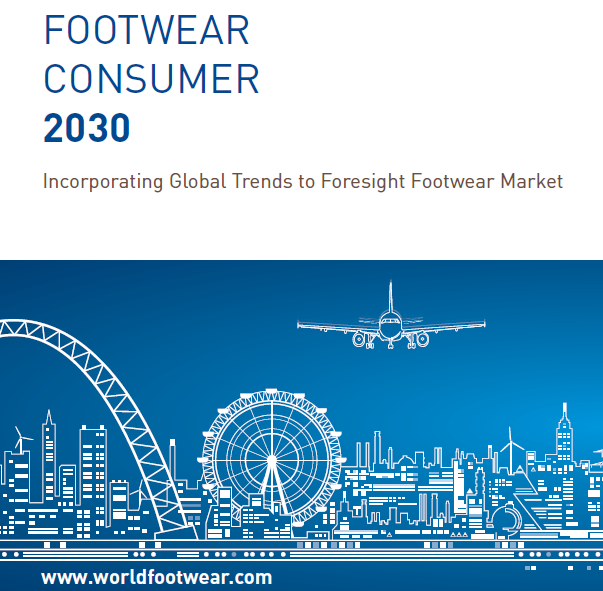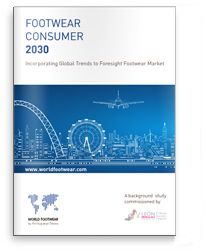Register to continue reading for free
World Footwear presents Footwear Consumer 2030

A study reflecting on the main global consumer trends with special attention to the key changes for the footwear industry and the foreseeable impacts on companies, brands and consumers
In a society with an economy characterised by change and volatility, the World Footwear team engaged on a reflection based on the trends that will impact on the world over the next few years. As a result of this exercise, insights on economic, demographic, social and cultural trends were gathered while considering their implications not only from a global point of view, but also focusing on the impacts in the footwear industry in particular.
The objective was not to forecast how the world will perform in economic or political terms, and an aim to quantify the impact of such tendencies in terms of industrial output or economic growth was never considered.The aim of this exercise was not to present numerical predictions of any kind but to identify existing trends and reflect upon them, as they have potential to gain further momentum over the next decades.
Focusing on topics such as globalisation, ageing and a growing middle class - trends undeniably in course - a reflection was done bearing in mind that these will occur in a global economy, in which access to information becomes more democratized and where consumers all over the world contact with the same messages, images and knowledge. Technology is developing fast, and access to the internet and major media channels results in consumer empowerment, impacting on the way buyers interact with the brands they acquire the products from. This also gives companies and brands the opportunity to develop an emotional bound with existing and potential clients all over the globe, greatly supported by social networks and online platforms.
While economic growth continues, a new middle class is starting to appear in emerging economies and this will have significant implications for demand, consumption and ultimately in production. Businesses will have to understand where the potential to grow their activity is and how and where can they potentially gain more clients. New markets in distant countries might become key destinations for brands and companies, resulting in diverse locations with customers with difference preferences and a varied demand with implications in the design of the products, which will require a constant attention devoted by companies to the product’s requirements.
Another element to bear in mind in this scenario is without any doubt the growing ageing population, which is not a recent phenomenon, and will continue to intensify. Countries from different continents are starting to face the consequences of having an older population, and although this is much more associated to developed western countries such as the United States or Europe, emerging and developing countries won’t be immune to the trend. On the contrary, China, for example, is one of the nations that will have to start to act upon this as it will be hit with the consequences of a rapidly ageing population over the next few years.
The only certainty one might have about the future is that it will be uncertain. However, despite all the unpredictability that lies in the years to come, one thing can be taken for granted: consumer preferences and behaviours will evolve as a result of changes in demography, economic growth and with the massification of information and communication. Businesses, companies and brands cannot ignore these facts, and it will be vital for them to act in anticipation instead of reacting quickly.
To read more about the main consumer trends and their foreseeable impacts on the footwear industry just download it free of charge below:
The objective was not to forecast how the world will perform in economic or political terms, and an aim to quantify the impact of such tendencies in terms of industrial output or economic growth was never considered.The aim of this exercise was not to present numerical predictions of any kind but to identify existing trends and reflect upon them, as they have potential to gain further momentum over the next decades.
Focusing on topics such as globalisation, ageing and a growing middle class - trends undeniably in course - a reflection was done bearing in mind that these will occur in a global economy, in which access to information becomes more democratized and where consumers all over the world contact with the same messages, images and knowledge. Technology is developing fast, and access to the internet and major media channels results in consumer empowerment, impacting on the way buyers interact with the brands they acquire the products from. This also gives companies and brands the opportunity to develop an emotional bound with existing and potential clients all over the globe, greatly supported by social networks and online platforms.
While economic growth continues, a new middle class is starting to appear in emerging economies and this will have significant implications for demand, consumption and ultimately in production. Businesses will have to understand where the potential to grow their activity is and how and where can they potentially gain more clients. New markets in distant countries might become key destinations for brands and companies, resulting in diverse locations with customers with difference preferences and a varied demand with implications in the design of the products, which will require a constant attention devoted by companies to the product’s requirements.
Another element to bear in mind in this scenario is without any doubt the growing ageing population, which is not a recent phenomenon, and will continue to intensify. Countries from different continents are starting to face the consequences of having an older population, and although this is much more associated to developed western countries such as the United States or Europe, emerging and developing countries won’t be immune to the trend. On the contrary, China, for example, is one of the nations that will have to start to act upon this as it will be hit with the consequences of a rapidly ageing population over the next few years.
The only certainty one might have about the future is that it will be uncertain. However, despite all the unpredictability that lies in the years to come, one thing can be taken for granted: consumer preferences and behaviours will evolve as a result of changes in demography, economic growth and with the massification of information and communication. Businesses, companies and brands cannot ignore these facts, and it will be vital for them to act in anticipation instead of reacting quickly.
To read more about the main consumer trends and their foreseeable impacts on the footwear industry just download it free of charge below:






